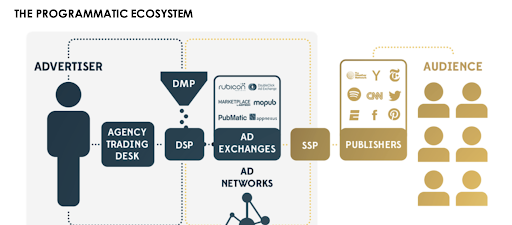Real-Time Bidding
Real-Time Bidding Overview
Learning the concept of Real-Time Bidding (RTB) helps you understand how programmatic bidding works and how you can utilize real-time bidding in your ad server. At a very basic level, real-time bidding is an open auction (think eBay) that provides inventory (publisher ad space) that can be bought and sold on a platform. Advertisers can purchase precisely targeted impressions across multiple publishers instead of a single publisher, while publishers can receive higher CPMs for their inventory.
The example below describes the end-to-end process for delivering an ad to a user via RTB.
Example
Before getting started, here are some important terms to know when understanding this example.
- User - Individual visiting a publisher’s web page
- Publisher - The website that has the requested content (e.g. New York Times)
- Publisher Content Server - The place where all of the publisher’s content is stored. This is what will be displayed on a webpage.
- Ad Content URL - A URL that tells the browser where to go to retrieve ad content.
- Publisher Ad Server - A logic engine that helps determine which ads to display to a user.
- SSP - A platform that enables publishers to sell display, mobile, and video ad impressions to potential buyers in real time via other DSPs, ad exchanges, and/or networks
- Ad Exchange - A platform that contains a collection of ad impressions that advertisers and publishers can buy and sell.
- Agency Ad Server - A server that contains the ads that can be displayed to a user.
Here is an example that demonstrates how this logic works:
-
A user navigates to the New York Times website to read the latest news and information.
-
When the user reaches the New York Times (the “publisher”) website, the web page is displayed.
-
Since The New York Times wants to try and monetize as much of their available ad space as possible, a request is made to the Publisher Ad Server to apply specific business logic that can help determine how best to proceed.
-
After reviewing existing business rules and logic, the Publisher Ad Server connects to an SSP.
-
The SSP applies additional business logic and rules, in addition to applying data insights, and sends an ad request to the Ad Exchange. The Ad Exchange will then communicate with its partners (DSPs, Networks, and other Ad Exchanges) to solicit bids for that ad space to determine the winning bid. Oftentimes, the SSP and the Ad Exchange are the same organization.
-
Once a bid is accepted, the DSP passes instructions to the Ad Exchange, telling it how to retrieve the ad.
The Ad Exchange then passes those instructions to the SSP, which is responsible for passing the request to the Publisher Ad Server. -
When the request is received, the Publisher Ad Server responds by connecting to the Agency Ad Server to retrieve the ad and display it to the user.
The figure below illustrates the end-to-end programmatic advertising process from Advertiser to Audience.

NOTE
Although this process consists of several steps, the actual time to execute this request is measured in milliseconds.
Updated 19 days ago
